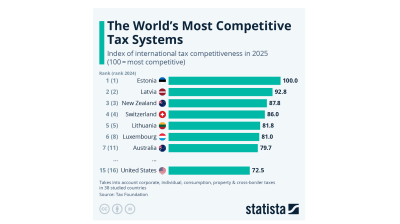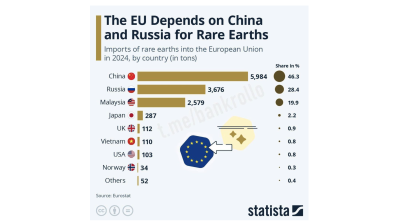This spring Central European and Baltic governments are launching austerity programmes to cut their swollen budget deficits at a time when interest rates are still painfully high and many of their economies have yet to emerge from recession.
Up to now Central European governments have relied on one-off measures such as windfall taxes on banks and energy companies to keep their budget deficits manageable. Now Czechia, Slovakia and Estonia are launching or preparing eye-watering cuts, and the EU Commission and IMF are calling for more.
“Consolidation should be even more ambitious than currently planned in most of the region,” said Kristalina Georgieva, IMF managing director, in a speech this week. “While this will require difficult choices, it will bring the triple benefit of reducing inflation, lowering debt service costs and bolstering financial stability.”
Last month the centre-right Czech government announced a set of measures aimed at reducing the fiscal gap from an anticipated 3.5% this year to below 2% of GDP next year and 1.2% of GDP in 2025. The CZK94bn (€4bn) package is split fairly evenly between spending cuts – including scrapping many subsidies and cutting central government costs by 5% – and tax rises, including a hike in corporate tax from 19% to 21%, increases in property taxes, excise taxes, health insurance contributions and a broadening of the tax base by changing allowances and tax thresholds. The package also promises a long-awaited reform of the pay as you go pension system.
The recently re-elected Estonian government, led by the centre-right Reform Party, has just pushed through a budget that includes raising VAT and income tax by two percentage points and higher excise duties. “We need a moratorium on state spending,” Kallas said in April. “That is the only way we can climb out of the hole. This also means looking some past decisions in the eye, which is another thing we must decide."
In Slovakia the new technocratic government of former central banker Ludovit Odor sees its main task before this September’s snap election as preparing an austerity budget to reduce the deficit from this year's roughly 6% of GDP to zero, as mandated by the country’s debt brake law. “We know Slovak public finances are at great risk," Odor said last month.
The major outliers are Poland and to a lesser extent Hungary, whose radical right-wing governments are still making populist promises to their electorates, despite yawning deficits and the freezing of vital EU aid payments because of their violations of the rule of law.
In Poland the Law and Justice (PiS) party has ignored the country’s already high inflation to announce a series of spending giveaways before this October’s election, notably a sharp jump in monthly child benefit from PLN500 to PLN800 (€178), as well as subsidised mortgages and higher public sector wages.
Geoff Gottlieb, the IMF’s senior regional representative for Central, Eastern and South-Eastern Europe, warned Poland recently that “a new fiscal impetus would likely add to inflationary pressures”. This could “necessitate additional monetary policy tightening,” Gottlieb told Reuters.
In Hungary the government has reined back some subsidies given out before last spring’s general election but it is relying on one-off windfall taxes on retailers, banks, pharmaceutical companies and energy suppliers to reduce the country’s huge budget deficit. Its current budget forecasts are seen as very optimistic by economists.
Swollen deficits
The region’s budget cuts are seen as essential to bring down deficits swollen by programmes to cushion the impacts of first the COVID-19 pandemic and then the spike in energy prices following the Russian invasion of Ukraine. These deficits have inflated public sector debt to record levels.
The cuts are also mandated by the EU. From the end of this year the European Commission will end the suspension of the Stability and Growth Pact, mandating governments to keep their budget deficits to within 3% of GDP from 2024 or risk being penalised under the Excessive Deficit Procedure.
Currently only Lithuania is expected to run a deficit of under 3% this year (2.3%), with Czechia at 3.5%, Estonia and Hungary at 4%, Latvia at 4.6%, Poland at 5% and Slovakia facing a 5.4% deficit.
Next year Hungary’s deficit is forecast to worsen to 4.4% of GDP, while those of Poland and Slovakia will remain elevated at 3.7% and 4.7% respectively. Czechia and the Baltic states should all just creep under the 3% threshold.

However, these budget cuts are happening when many countries are still mired in recession as high energy prices, inflation and interest rates batter consumers and companies. Hungary, Estonia and Lithuania are still in technical recession (two or more consecutive quarters of q/q decline). Czech GDP was flat quarter on quarter in Q1, and the economy remains below its pre-COVID-19 levels.
This wave of cuts also coincides with Western Europe’s later slide into recession, with the German economy declining q/q for the second consecutive quarter in Q1 (by 0.3%), meaning the region’s main trading partner is also now in a technical recession.
Many CEE countries have observed declining q/q GDP growth since 3Q22, though most downturns have been fairly shallow, with falls in domestic consumption up to now cushioned by foreign trade surpluses and the consumption boost from the huge wave of Ukrainian refugees. Now, stagnation or recession in the Eurozone threatens to dampen any nascent recovery.
This year only Slovakia is expected to grow more than 1%, with Polish GDP growth predicted at just above zero, and Czechia, Hungary, Latvia and Lithuania clustered around zero. Estonia is forecast to have a second year of recession, with the EBRD predicting a decline of 1.3% and the IMF one of 1.2%.
In 2024 all countries are forecast to return to growth of between 2-3% – hardly the pace they need to achieve to close the still considerable gap with Western European levels of prosperity. The austerity programmes therefore risk deepening the economic gloom in a region that since the 2007-9 Global Financial Crisis has struggled to return to the convergence path.
Central bank caution
Austerity is also being imposed at a time when monetary policy is still tight because of soaring inflation, pumped up by rising energy and food prices.
Inflation hit levels in CEE unseen in Western Europe, partly because of the weight of energy and food in consumer price index baskets, as well as the continuing tight labour markets, which have pushed up wages sharply in several countries (though often it has fallen in real terms). Hungarian inflation hit 25.6% year on year in March, the highest rate in the EU.
Inflation is now coming down as food and energy prices ease, though core inflation, which strips out those volatile prices, is still stubbornly high. In most countries inflation is only expected to be back into single digits at the end of the year.
Central banks have hiked interest rates to bring down inflation, even though the impact has been limited because most of the inflation push is imported. By doing so they have also often been working at cross-purposes with governments, creating tensions, as their tight monetary policies hurt the companies and consumers that governments are trying to support with their generous subsidy programmes.
The region’s three independent central banks (Slovakia and the Baltic states are in the Eurozone) were the first in the EU to raise rates – and to much higher levels than in Western Europe – and have so far been very reluctant to start to lower them.
Only the Hungarian National Bank (MNB) – which was the first in the EU to raise rates in April 2022 – has begun loosening, by reducing the interest rate on the one-day quick deposits offered at daily tenders by 100bp to 17% last month.
The Czech central bank, which has held its key rate at 7% for a year, had been anticipated to start cutting rates this summer but now the speculation is over a move in the other direction, after a knife-edge 4:3 vote to hold the key rate at 7%, with hawks pushing for a rise. Most analysts now forecast a rate cut only at the end of the year.
Poland’s central bank has kept its reference interest rate at 6.75% – a 20-year high – since September, and appears deeply divided over whether to begin loosening at the end of this year or to postpone it even longer.
The IMF has signalled caution and has even suggested some central banks should consider further raises. “Countries with independent central banks will need to keep a tight policy stance – and possibly tighten further if inflation remains sticky,” Georgieva said in her speech this week.
Getting the balance right
The key challenge for policymakers is getting right this balance between monetary and fiscal policy and calibrating the speed of cuts in deficits and interest rates. If governments slash budget deficits at a time when central banks are keeping interest rates high, this risks worsening the region’s economic stagnation.
This could have grave political repercussions in a region where populism is already rampant. Populist opposition parties are already exploiting the budget cuts, mounting filibusters in parliament in Czechia and Estonia. In Slovakia, the left-wing populist Smer Party is leading opinion polls ahead of September’s snap election and is set to benefit from the technocrat government’s balanced budget proposals.
However, if budget deficits and public debt levels are allowed to remain elevated, and interest rates are cut too fast, this could entrench inflationary expectations and lead to a loss of market confidence.
Hungary is probably the biggest worry here. Prime Minister Viktor Orban’s pre-election spending splurge left it with a deficit of 6.2% of GDP last year and gross public debt of 76.1% of GDP – the worst in the region – as well as the highest inflation and interest rates in Europe. In Q1 the economy remained in recession for the third consecutive quarter, declining by 0.3% q/q.
The central bank has had to do the heavy lifting to damp down the economy because the government has merely pruned its thicket of populist handouts to voters and still prioritises economic growth.
The country’s Fiscal Council warned last month that a further delay in EU funds, slower economic growth in Hungary’s main export markets or the prolongation of the Ukraine war could jeopardise the 2023 budget’s (very optimistic) revenue targets.
The erratic and highly unorthodox policies of the government and central bank have failed to reassure investors in Hungarian assets. Further slippage in the budget figures could make the Hungarian forint – the worst performing EU currency last year – once again the punchbag of the markets.
Further reporting by Wojciech Kosc in Warsaw, Albin Sybera in Prague and Linas Jegelevicius in Vilnius.
Features
_1762193126.jpg)
Is Venezuela's resource wealth Trump's real target?
As US military forces mass in the Caribbean, Venezuela's oil and mineral wealth emerges as a potential prize in a looming confrontation that will likely result in the ousting of President Nicolas Maduro.

The US now sees China as an equal - it is time for Western media to wake up and do the same
China was long filed under “too foreign, too dangerous, too different” in many Western newsrooms. Not anymore. Beijing is now impossible to ignore as American leaders have realised. Western media outlets need to wake up to this reality too.

COMMENT: China’s latest economic conquest – Central Asia
For the five Central Asian republics - Kazakhstan, Kyrgyzstan, Tajikistan, Turkmenistan and Uzbekistan - China has in recent years emerged not only as a dominant trading partner, but increasingly as the only partner nearby that can actually deliver.

Slovenian consumers take energy giant GEN-I to court over price hikes
The Slovene Consumers’ Association accused GEN-I of unlawfully raising household prices at the height of the recent energy crisis.




